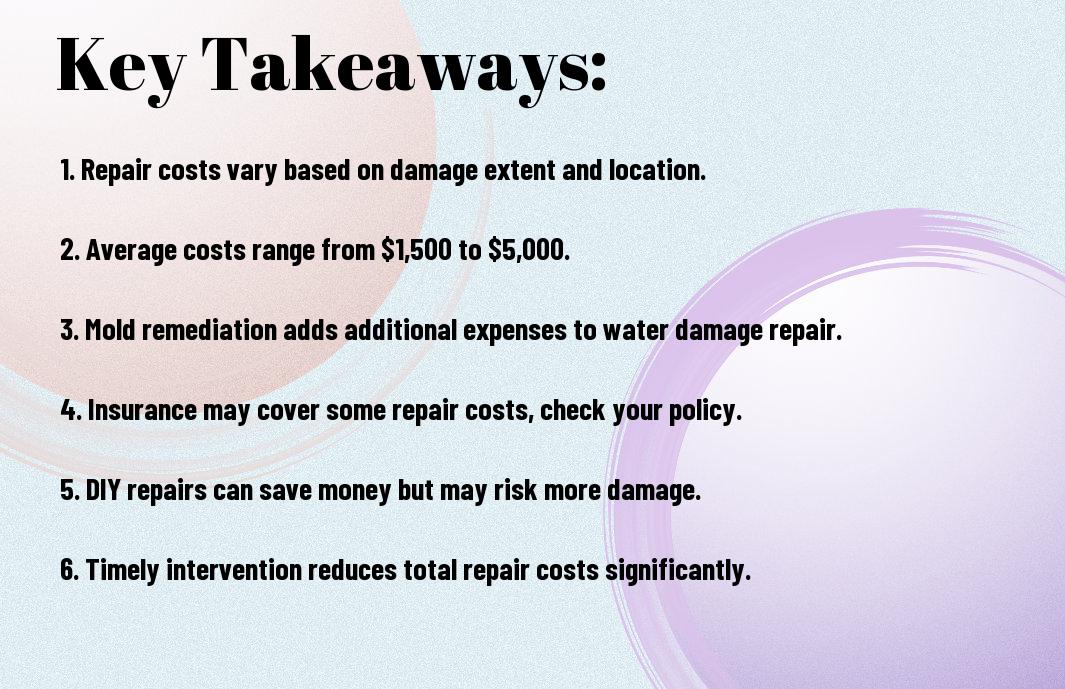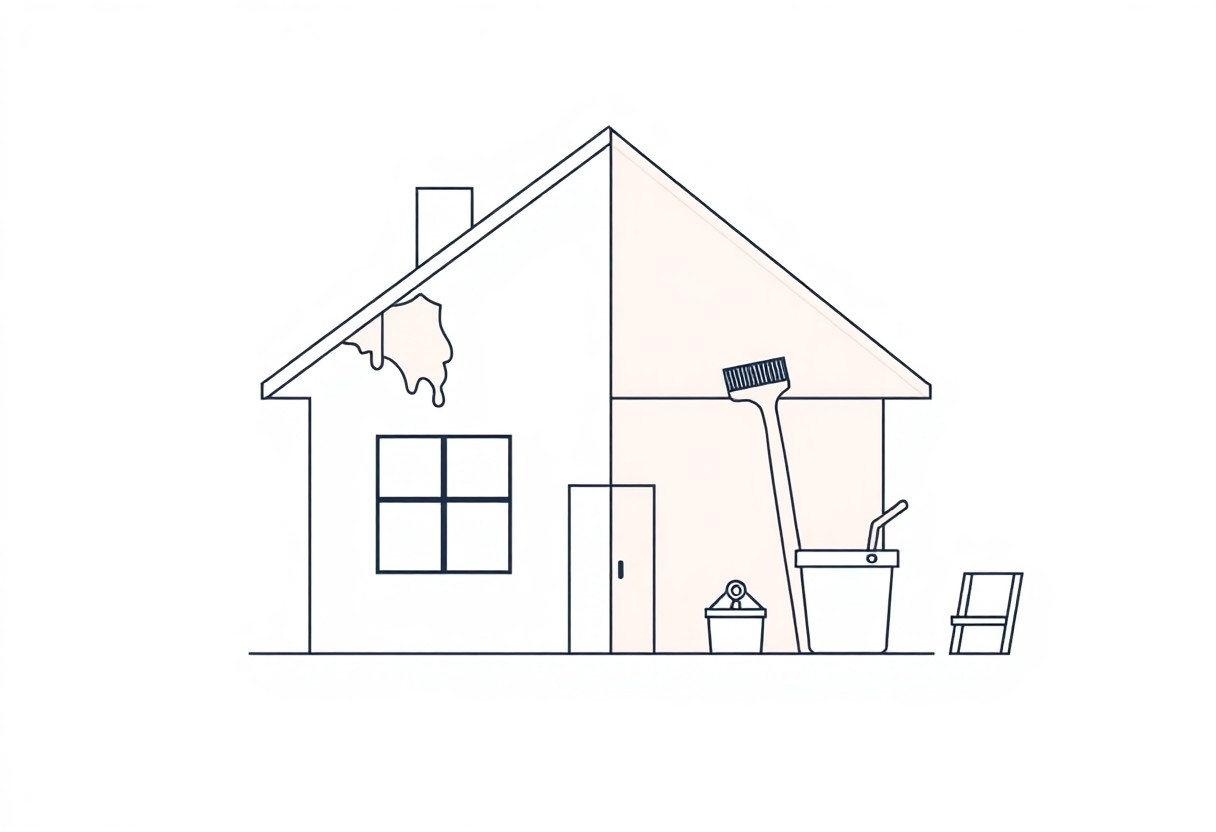Most homeowners find themselves facing the daunting reality of water damage at some point, whether from a natural disaster, plumbing issues, or appliance malfunctions. Understanding the potential costs involved in repairing this damage can help you navigate the situation with greater confidence. In this post, we will explore the various factors that influence repair costs, including the extent of the damage, necessary repairs, and potential restoration services. By the end, you’ll have a clearer idea of what to expect when tackling water damage in your home.
Need Emergency Water Damage Restoration?
Contact Service Restore Pro today for 24/7 emergency response. Our certified technicians will provide a thorough assessment, detailed estimate, and professional water damage restoration services.
Call (612) 488 9558
Need Emergency Water Damage Restoration?
Contact Service Restore Pro today for 24/7 emergency response. Our certified technicians will provide a thorough assessment, detailed estimate, and professional water damage restoration services to get your property back to pre-loss condition.
Understanding Water Damage Categories
The categories of water damage are classified based on the source of water and the potential risk to human health. Understanding these categories helps you assess the situation and determine the necessary steps for repair and restoration. Each category requires a different approach to cleanup and mitigation, influencing both the extent of damage and the overall cost of recovery efforts.
Clean Water Damage (Category 1)
Category 1 refers to clean water damage, which originates from a source that poses no threat to human health, such as a broken pipe or a supply line leak. This type of damage is often easier and less expensive to repair, as it typically involves the removal of water and drying out affected areas.
Gray Water Damage (Category 2)
To understand gray water damage, this category includes water that may contain some contaminants, such as from dishwashers or washing machines. While it is not as hazardous as black water, it can still cause discomfort and potential health risks if not addressed promptly. And while gray water may seem less threatening, it is crucial to tackle it quickly because it can promote the growth of mold and bacteria within your home. Addressing gray water damage often involves not just removing the water, but also cleaning and sanitizing the affected area to minimize health risks and restore your living environment.
Black Water Damage (Category 3)
Damage caused by black water is the most severe category of water damage. This water typically comes from unsanitary sources, such as sewage backups or flooding from rivers. Black water poses significant health risks due to the presence of harmful pathogens and toxins. Damage from black water requires immediate attention and professional intervention. Since this category involves hazardous waste, you should never attempt to clean it yourself. Skilled professionals use specialized equipment and techniques to handle black water safely, reducing the threat to your health and ensuring your property is restored effectively. 
Common Types of Water Damage
Some of the most prevalent types of water damage that homeowners face include:
- Flooding from natural disasters
- Leaking pipes and plumbing issues
- Appliance malfunctions, like washing machines
- Roof leaks from storms
- High humidity and condensation problems
Any type of water damage can lead to significant repair costs, so understanding how much it costs to fix water damage is necessary for your budgeting.
| Type of Damage | Description |
|---|---|
| Structural Damage | Damage affecting the integrity of your home's structure. |
| Flooring Damage | Damage to hardwood, carpet, or tile flooring. |
| Wall Damage | Blemishes or warping in drywall or plaster. |
| Mold Growth | Fungal growth due to excess moisture. |
| Appliance Damage | Damage to household appliances impacted by water. |
Structural Damage
On many occasions, water damage threatens the structural integrity of your home. This can occur when water seeps into walls, foundations, or floors, leading to serious issues like sagging ceilings or warped beams. If not addressed promptly, structural damage can result in expensive repairs and even compromise the safety of your living space.
Flooring and Wall Damage
Common types of damage to flooring and walls include warping, discoloration, and mold growth. If moisture persists, it can lead to more severe issues that compromise both aesthetics and safety. Considering the various materials your flooring and walls are made of, the repair costs can differ significantly. Hardwood may require complete replacement, while carpets can dry out or be cleaned. For walls, monitoring for damage and acting quickly can save you time and money in repairs.
Mold Growth and Remediation
Remediation of mold growth is necessary for maintaining a healthy living environment. When water damage occurs, mold can proliferate within 24 to 48 hours, posing health risks and structural issues. Mold can be challenging to eliminate once it establishes itself, so it's important to consult professionals for effective remediation services. You want to ensure that not only is the mold removed, but the conditions that allowed it to develop are also addressed to prevent recurrence.
Cost Factors
Many factors influence the overall cost of water damage repair. Key components include:
- Extent of damage
- Type of water source
- Location and accessibility
- Necessary repairs and replacements
After understanding these elements, you can better anticipate the costs involved in water damage restoration. For further insights, check out Water Damage Restoration Cost [2025 Data].
Extent of Damage
One of the primary cost determinants is the extent of damage. The more significant the damage, the higher the repair costs. Early action can minimize the damage and reduce expenses.
Type of Water Source
Extent of water source also plays a vital role in repair costs. Clean water from a broken pipe generally requires less intensive restoration than contaminated water from sewage backups. Damage from contaminated water can introduce health risks and necessitate additional safety measures during the cleanup. This can significantly increase overall repair costs and complicate the restoration process.
Location and Accessibility
About where the water damage occurs impacts costs too. Areas that are harder to access might increase labor time and expense, affecting your overall budget. The proximity to plumbing, electrical systems, and overall structural conditions also matter. If your damaged area is hidden behind walls or ceilings, it can lead to additional work, enhancing the overall repair cost. 
Average Repair Costs
Now, understanding the average repair costs for water damage can help you budget effectively. Typically, costs can range from a few hundred to several thousand dollars, depending on the extent of the damage, the location of the water intrusion, and the materials involved in the repair process. Quick response and mitigation can significantly impact the overall costs, so acting promptly is vital.
Small-Scale Repairs
Beside minor leaks that may cause minimal damage, small-scale repairs often include fixing small spots of water damage, such as stained ceilings or moldy patches on drywall. These repairs typically cost between $500 to $1,500, depending on the materials required and the extent of the damage.
Medium-Scale Repairs
About medium-scale repairs involve issues like water-damaged flooring or significant drywall replacement. Costs for these repairs generally range from $1,500 to $5,000. Factors that can influence these costs include labor rates and the materials chosen for the restoration. Plus, proper assessment is key to ensuring that the underlying issues are addressed, which might involve further inspections to identify any hidden damage, such as mold growth or structural concerns. Solutions may involve better waterproofing or more extensive rebuilding processes, further affecting your total costs. Assess these needs before proceeding with repairs.
Large-Scale Repairs
Before undertaking large-scale repairs, it's important to understand that extensive damage can occur in cases of flooding or significant leaks. These repairs often involve complete restoration of entire rooms or floors and can range from $5,000 to $20,000 or more, depending on damage severity and the necessary construction work. In addition, large-scale repairs may require the involvement of specialized contractors, demolition, and rebuilding, which can greatly increase overall expenses. It's critical to get detailed quotes and timelines from professionals to manage your budget effectively and ensure that all safety standards and procedures are followed during the restoration process.
Insurance Coverage
Unlike general property damage, water damage is often specifically addressed in homeowners' insurance policies. You will need to check your policy details to understand the extent of coverage available for water damage, as some policies may have specific exclusions or limits based on the cause of the damage, such as flooding or sewer backup.
What Insurance Typically Covers
Among the types of water damage typically covered under standard homeowners' insurance policies are sudden and accidental damages, such as those caused by burst pipes or overflowing bathtubs. However, coverage can vary greatly, so it's important to review your policy or speak with your insurance agent for personalized insights into your coverage.
Out-of-Pocket Expenses
Expenses related to water damage repairs can add up quickly, especially when your insurance does not cover certain costs. This could include deductibles, repairs outside of the covered damages, or costs arising from pre-existing issues. Hence, you should be aware that even with insurance, you may still incur out-of-pocket expenses. These could include high deductibles or costs for temporary accommodations while repairs are made, as well as any restoration work that exceeds insurance limits. Planning ahead and setting aside an emergency fund can help mitigate the financial impact of unexpected water damage situations.
Prevention and Maintenance
To effectively manage water damage, implementing prevention and maintenance strategies is crucial. Regular upkeep of your property can significantly reduce the risk and cost associated with water-related repairs. By being proactive, you can safeguard your home against unforeseen damages and prolong the lifespan of your investments.
Regular Inspections
One effective method to prevent water damage is through regular inspections of your property. Routinely assess areas prone to leaks, such as roofs, basements, and plumbing fixtures. This diligence allows you to identify potential issues early, ensuring timely repairs and minimizing extensive damage.
Preventive Measures
Preventive measures play a vital role in protecting your property from water damage. Simple actions like maintaining gutters, properly grading landscaping, and sealing cracks in your foundation can significantly reduce water intrusion risks. Additionally, regular maintenance of appliances that use water, such as washing machines and dishwashers, can help you avoid costly repairs. Considering these preventive strategies can help you maintain a dry and safe environment. Investing time in simple upkeep tasks, such as clearing your gutters or applying waterproof sealants, not only preserves your home's integrity but can also save you from future repair expenses. By taking control of your property's maintenance, you enhance its resilience against water damage.
Early Detection Systems
Among the best strategies for preventing serious water damage are early detection systems. These tools can alert you to leaks or rising water levels before they escalate, allowing for immediate action. Installing water leak sensors in key areas such as basements and near plumbing lines can protect your home and belongings from substantial damage. Measures like integrating smart home technology can enhance your ability to monitor your property's condition. These systems often provide real-time alerts to your smartphone, allowing you to address issues promptly. By being proactive and utilizing early detection systems, you decrease the likelihood of extensive water damage and its associated costs, ensuring a safer living environment for you and your family.
Summing Up
Presently, the cost to repair water damage varies significantly based on the extent of the damage, the size of your property, and the repair methods required. You can expect to pay anywhere from a few hundred to several thousand dollars, depending on factors like mold remediation and structural repairs. It is advisable to assess your situation quickly and consult with professionals for accurate estimates, ensuring you take prompt action to minimize further damage and costs to your home.

